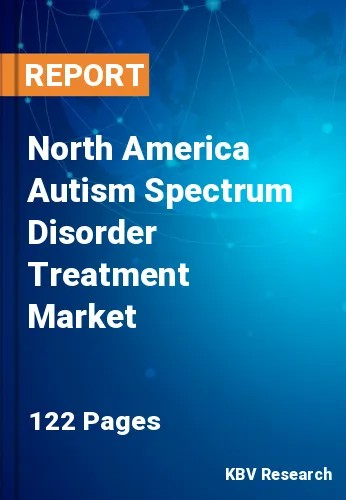The North America Autism Spectrum Disorder Treatment Market would witness market growth of 5.1% CAGR during the forecast period (2023-2030).
The rising incidence of autism is expected to increase demand for medications used to treat people who exhibit symptoms of autism spectrum disorders and to enhance revenue generation. The essential seven conditions that are a part of ASD, according to the Autism Research Institute (ARI), are Fragile X Syndrome, Williams Syndrome, Landau-Kleffner Syndrome, Prader-Willi Syndrome, Angelman Syndrome, Tardive Dyskinesia, and Rett Syndrome. ASD-like symptoms like hand flapping, strange movements, and poor eye contact are present in 15% to 20% of people with fragile X syndrome. Thus, it is projected that an increasing number of autistic patients would fuel the market, along with late-stage pharmaceutical candidates like Zygel and STX209 (Arbaclofen).
Patients with ASD demonstrate a high degree of schedule dependence, a high level of sensitivity to changes in their surroundings, or a strong fixation. Early management improves symptom improvement over time, even if the illness is lifelong. Early detection guarantees early intervention during the critical developmental phase.
The prevalence of ASD, rising investment levels, and research & development spending are the main drivers of market expansion. The 2019 Canadian Health Survey on Children and Youth (CHSCY) found that 1 in 50 (or 2.0%) Canadian children and teens between the ages of 1 and 17 had an ASD diagnosis. Ages 5 to 11 had the highest prevalence of ASD (1 in 40 or 2.5%), followed by 12 to 17 years (1 in 53 or 1.9%) and ages 1 to 4 years (1 in 91 or 1.1%). The federal, state, and provincial governments in the United States and Canada have started a number of programs to help people with ASD, including financing for early intervention services, educational programs, and research. The market is expanding as a result of the market participants' rising number of initiatives. Such advancements are anticipated to encourage the creation of medications and consequently spur market expansion.
The US market dominated the North America Autism Spectrum Disorder Treatment Market, by Country in 2022, and would continue to be a dominant market till 2030; thereby, achieving a market value of $896.2 Million by 2030. The Canada market is poised to grow at a CAGR of 7.5% during (2023 - 2030). Additionally, The Mexico market would witness a CAGR of 6.6% during (2023 - 2030).
Based on Type, the market is segmented into Stimulants, Antipsychotic Drugs, Selective Serotonin Reuptake Inhibitors, Sleep Medications, and Others. Based on Application, the market is segmented into Autistic Disorder, Asperger Syndrome, Pervasive, Developmental Disorder, and Others. Based on Distribution Channel, the market is segmented into Retail Pharmacy, Hospital Pharmacy and Online Pharmacy. Based on countries, the market is segmented into U.S., Mexico, Canada, and Rest of North America.
Free Valuable Insights: The Worldwide Autism Spectrum Disorder Treatment Market is Projected to reach USD 3 Billion by 2030, at a CAGR of 6.2%
The market research report covers the analysis of key stake holders of the market. Key companies profiled in the report include F. Hoffmann-La Roche Ltd., Bristol Myers Squibb Company, Merck & Co., Inc., Novartis AG, Eli Lilly And Company, Pfizer Inc., Johnson & Johnson, Otsuka Pharmaceutical Co., Ltd., Yamo Pharmaceuticals, and Curemark LLC.
By Type
By Application
By Distribution Channel
By Country
Our team of dedicated experts can provide you with attractive expansion opportunities for your business.

